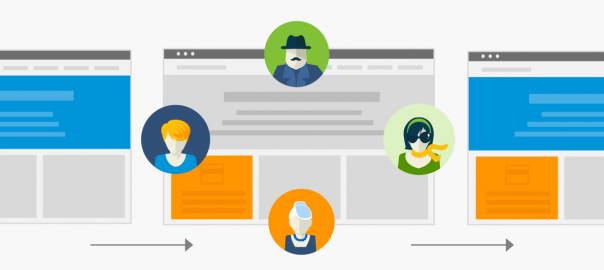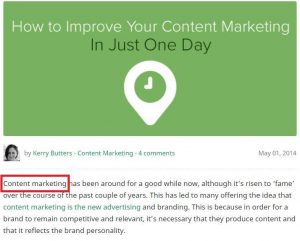
Like many businesses, we find that blogs are a critical source of traffic. At Evergage, over 50% of the traffic to our site comes in through this very blog! It’s a critical component of our website and demand generation strategy.
To generate valuable traffic to your own blog, you probably put a lot of work into releasing a steady flow of quality content. Make sure that these efforts aren’t wasted once readers arrive at your blog — provide them with value to encourage them to stay on your site longer.
Personalization is a great way to help your readers find posts that are most relevant to them, providing them with that additional value. Let me take you through a roadmap with 6 ideas to help you make sure you’ve completely optimized engagement with your blog.
1. Suggest other relevant posts while reading current one
When it comes to personalizing your blog, a good place to start is to encourage visitors to read a second post after their first one. You likely have many first-time visitors that arrive to your blog to view a few particularly popular posts. Suggesting another post while they are finishing the current one might entice them to continue reading, even if they were not planning to stay. But don’t just offer a random article (like your most recent post or what’s most popular), make sure it is related to the content they are currently viewing.
We do this on the Evergage blog by recommending the latest article in the category the visitor is currently viewing — like the example below.

2. Recommend relevant posts based on past behavior
Once a visitor gets further engaged with the blog, the logic for recommended articles can and should get a little more sophisticated as well. For return visitors and visitors who have viewed multiple articles, your recommendations should leverage this known behavior.
For example, we automatically recommend the most recently published article in the visitor’s preferred blog category – based on time spent per category. Plus we exclude articles that have already been viewed.
3. Upon exit, suggest relevant content
If a visitor shows signs of leaving your blog, you can offer another article or piece of content to re-engage the visitor and increase his or her activity on your site. But just like in the examples above, make sure that the content is tailored to the interests of the visitor based on other articles they have read.
In the Evergage example below that’s garnered tremendous success, we offer a relevant eBook when someone is about to leave the site. We’ve found through testing that it results in the most lead conversions, but you could also recommend relevant blog posts or any other pertinent asset that will keep the visitor engaged on your site longer.
4. Ask for email at the right time
Many blog owners grow their readership by sending email newsletters to people who have already indicated interest. But when is the best time to ask someone to subscribe?
Through testing, our clients have discovered that the best time to ask a visitor to subscribe to email updates is when they’ve already engaged with the content in some capacity — not when they first land on your site.
Test different message formats, placements, timing, etc. to make sure that you know the best time to ask someone to form a relationship with you. This may be after the user reads one blog post or three — test until you find the formula that works for you.
5. List featured posts, personalized for the visitor
You may have a list of featured posts down the side of your blog, but how is it organized? By most recent posts? Most popular posts? This could (and likely does) lead to increased engagement with your posts, but try personalizing this list for each reader instead so it’s more relevant.
There are many different variables you could consider. For example, you could feature the most popular posts in the category the visitor prefers, the posts that include the visitor’s preferred tags or keywords, or the most recent unread articles by the reader’s favorite author. It all depends on your content and what would be most engaging to your readers (best determined through testing, of course).
6. Suggest a post that has led to conversions in the past
Don’t limit yourself to recommendations on your blog — you can also promote your blog posts across the rest of your site. Let’s say that a visitor to your site is researching product X. If one of your blog posts has been most effective at converting researchers of that product – which can be systematically determined – then show the visitor a call-to-action (CTA) to check out that post.
With this approach, you are incorporating what you know about how others have behaved in the past to deliver an experience to a visitor in real time. And you are promoting your blog content to someone currently doing research on your site.

Wrap Up
If you or your company blogs regularly, you have a lot of content on your site. Personalization can help you ensure that each reader sees the posts that he or she will find most interesting and valuable.
Whether you are a beginner at personalization or are looking for something a little more sophisticated, you can use these tips to improve blog engagement!
Digital & Social Articles on Business 2 Community(75)






